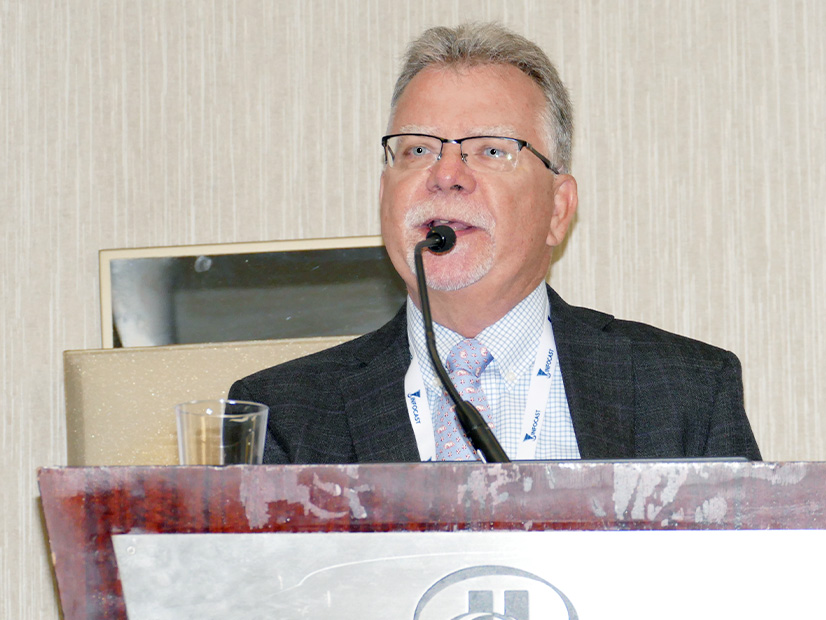ARLINGTON, Va. — You’d be hard pressed to find a bigger booster of grid-enhancing technologies (GETs) than former SPP planner Jay Caspary, now vice president of consultancy Grid Strategies.
Speaking at the Infocast Transmission & Interconnection Summit last week, Caspary used the adjective “great” to describe topology optimization, storage as transmission and the ability to redeploy GETs at different spots on the grid.
“And that’s great … because congestion is going to move as we start building the grid,” he said. “So we can move this stuff around to where it’s most effective.”
Several other speakers — but not all — shared Caspary’s enthusiasm during the three-day conference.
 Bhaskar Ray, Q CELLS USA | © RTO Insider LLC
Bhaskar Ray, Q CELLS USA | © RTO Insider LLCBhaskar Ray, vice president of development and interconnection engineering for Q CELLS USA, said planners should consider dynamic line ratings, which have proven valuable in operations. “I think we need to take a closer look in the planning mode to see if we can squeeze out another 10 to 15% of the transmission” capacity, he said.
Kenneth Jennings, general manager of renewable integration and operations for Duke Energy (NYSE:DUK), said he’s looking forward to the comments on storage as a transmission asset (SATA) in FERC’s June 16 Notice of Proposed Rulemaking on generator interconnection (RM22-14).
“I think it’ll be interesting to see what the comments are around transmission alternatives as far as the solutions to solve an overload,” he said. “I think that might open up an opportunity to look at storage differently perhaps than we do today. In general, we think about storage as requiring an interconnection request. It may make sense not to have an interconnection request for storage if it’s solving an overload.”
 Kenneth Jennings, Duke Energy | © RTO Insider LLC
Kenneth Jennings, Duke Energy | © RTO Insider LLCCaspary also sees an increasing role for SATA. “I think we need to consider that more and more to help create capacity on a system where we need it in the near term.”
He said he’s happy that FERC proposed requiring transmission planners to consider power flow controllers — phase-shifting transformers and phase angle regulators — that have been used on the grid for decades.
He also cited research that found replacing existing lines with advanced conductors could allow the addition of up to 30 GW of renewables to the system.
“We’re going to have to replace a lot of the existing wires on our transmission system over the next decade; I think we’ve estimated maybe 200,000 miles of lines [and] conductors that are going to reach their end of economic life in the next decade. That’s a lot of opportunity to increase capacity in existing corridors and leveraging existing structures,” he said. “Let’s be smart about this.”
 Bart Franey, National Grid | © RTO Insider LLC
Bart Franey, National Grid | © RTO Insider LLCBut Bart Franey, director of transmission business development for National Grid (NYSE:NGG), was much less bullish than the other speakers, saying GETs will be limited to a “niche role.”
“DLR is not a substitute for rebuilding a line. When you have a 300% thermal overload on a light load day, you’re not going to put in DLR to fix that problem. I think, though, that it can work for minor overloads or as a stopgap solution. Power flow control devices [are] very, very handy, provided you have a parallel line where you can shunt the power over to it. … Advanced conductors … also have a specific application. It’s hard to put advanced conductors on a 100-year-old tower, because it can’t hold the tension. So I think there is a niche role.”
Franey shares the enthusiasm for storage as transmission, however. “I think there’s great opportunity that hasn’t really been tapped into,” he said. “I really think that there are just so many operational, reliability, transmission-type products that storage can offer in one setting and through some clever operations. I think that is going to be a key to an [non-wires alternative] type solution.”
FERC Commissioner Allison Clements said there is “more to come” from the commission on SATA. “Don’t take that as the commission plans to take action on that in the near term,” she cautioned. “I think there is a need to continue to think along those lines to see where the commission has landed in past decisions, and where we should go from there.”



